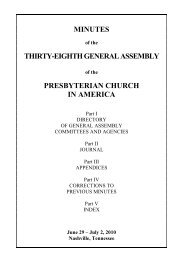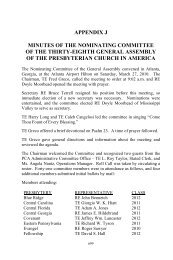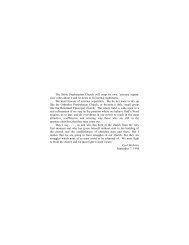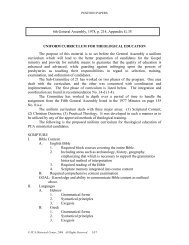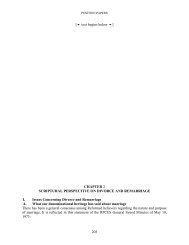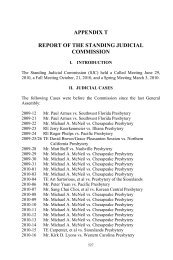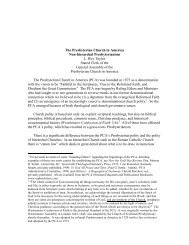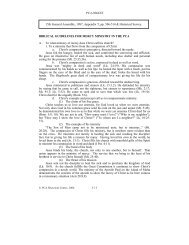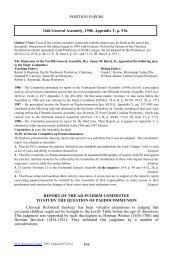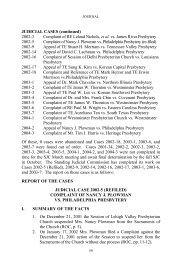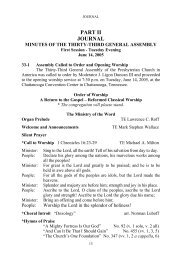Chapter 5: The Broadening Church in the USA - PCA Historical Center
Chapter 5: The Broadening Church in the USA - PCA Historical Center
Chapter 5: The Broadening Church in the USA - PCA Historical Center
Create successful ePaper yourself
Turn your PDF publications into a flip-book with our unique Google optimized e-Paper software.
162 <strong>The</strong> <strong>Broaden<strong>in</strong>g</strong> <strong>Church</strong> In <strong>the</strong> U.S.A.estantism, Mediat<strong>in</strong>g Modernism, and <strong>the</strong> Com<strong>in</strong>g Catholicism.„Modernism is <strong>the</strong> embodiment of <strong>the</strong> Zeit-Geist, <strong>the</strong>spirit of our age, that our Lord is us<strong>in</strong>g to mediate between<strong>the</strong> past and future of his K<strong>in</strong>gdom.‟ 31 <strong>The</strong> traditional differencesamong <strong>the</strong> denom<strong>in</strong>ations are fast disappear<strong>in</strong>g and anentirely new l<strong>in</strong>e of cleavage is appear<strong>in</strong>g—that between <strong>the</strong>modernists and medievalists. 32 However, <strong>in</strong> Hegelian fashionthis conflict will be resolved to produce a better, universal<strong>Church</strong>. Indeed, „<strong>the</strong> <strong>Church</strong> has always from <strong>the</strong> beg<strong>in</strong>n<strong>in</strong>gbeen grow<strong>in</strong>g better.‟ F<strong>in</strong>ally this Com<strong>in</strong>g Catholicism willbr<strong>in</strong>g about not only <strong>the</strong> reconciliation of Christian andChristian but Christian and Jew. 33We see, <strong>the</strong>n, that <strong>in</strong> modernism one th<strong>in</strong>g leads to ano<strong>the</strong>r.<strong>The</strong>re is first of all <strong>the</strong> denial of <strong>the</strong> authority ofScripture <strong>in</strong> any effective sense; <strong>the</strong>n denial of fundamentalChristian doctr<strong>in</strong>es with particular opposition to <strong>the</strong> systemtaught <strong>in</strong> <strong>the</strong> Confession; and, f<strong>in</strong>ally, a will<strong>in</strong>gness to toleratealmost any type of teach<strong>in</strong>g with<strong>in</strong> <strong>the</strong> Christian <strong>Church</strong>.1909, 345 ff., 350 ff., 360 ff. Cf. 319, 426 ff. By this time, of course, Briggs wasno longer <strong>in</strong> <strong>the</strong> Presbyterian <strong>Church</strong>, U.S.A. See below. [pp. 164-165]31. Ibid., 440. Cf. 439 f., where Briggs amplifies this judgment: 1) „Modernistsuse <strong>the</strong> method of Biblical Criticism and accept its results without hesitation.‟This destroys <strong>the</strong> dogma of <strong>the</strong> <strong>in</strong>errancy of Scripture. 2) „Modernist study<strong>Church</strong> History by <strong>the</strong> methods of <strong>Historical</strong> Criticism.‟ This does away withtraditional history. 3) „Modernists study dogmas by <strong>the</strong> use of modern philosophy.‟4) „Modernists accept without hesitation <strong>the</strong> results of Modern Science.‟ E.g.<strong>the</strong> pr<strong>in</strong>ciple of evolution. „All Modernists see <strong>in</strong> <strong>Church</strong> History a development,or evolution, of <strong>in</strong>stitution and doctr<strong>in</strong>e.‟ 5) „Modernists advocate a reform of <strong>the</strong><strong>Church</strong> and its <strong>in</strong>stitutions <strong>in</strong> accordance with modern methods of governmentand discipl<strong>in</strong>e, and with scientific, social and economic pr<strong>in</strong>ciples. <strong>The</strong>y practice<strong>the</strong> active ra<strong>the</strong>r than <strong>the</strong> passive virtues, and urge more comprehensiveness andefficiency <strong>in</strong> religious work. This <strong>in</strong>volves practical reform all along <strong>the</strong> l<strong>in</strong>e.‟32. Cf. a similar statement as early as 1889: „<strong>The</strong> sectarian divisions arebecom<strong>in</strong>g merged <strong>in</strong> <strong>the</strong> vastly greater and more important conflict between <strong>the</strong>conservatives and <strong>the</strong> progressives <strong>in</strong> all <strong>the</strong> <strong>Church</strong>es.‟ Whi<strong>the</strong>r?, 296.33. <strong>Church</strong> Unity, 450 f. Cf. 450: „When <strong>the</strong> great fundamental Catholicpr<strong>in</strong>ciple of Holy Love has become <strong>the</strong> material pr<strong>in</strong>ciple of entire Christianity, itwill fuse all differences, and, like a magnet, draw all <strong>in</strong>to organic unity about <strong>the</strong>centre where love itself truly reigns. Noth<strong>in</strong>g <strong>in</strong> this world can stand aga<strong>in</strong>st such aCatholic <strong>Church</strong>. She will speedily draw all mank<strong>in</strong>d <strong>in</strong>to <strong>the</strong> K<strong>in</strong>gdom of ourGod and Saviour.‟This digital edition prepared by <strong>the</strong> staff of <strong>the</strong> <strong>PCA</strong> <strong>Historical</strong> <strong>Center</strong>, 2009.



